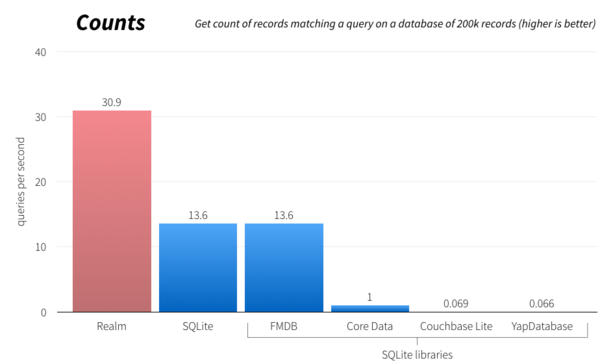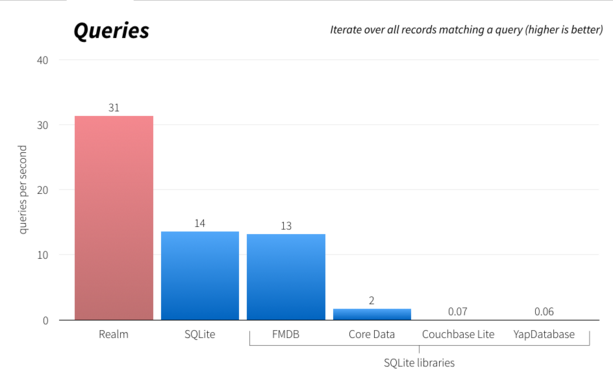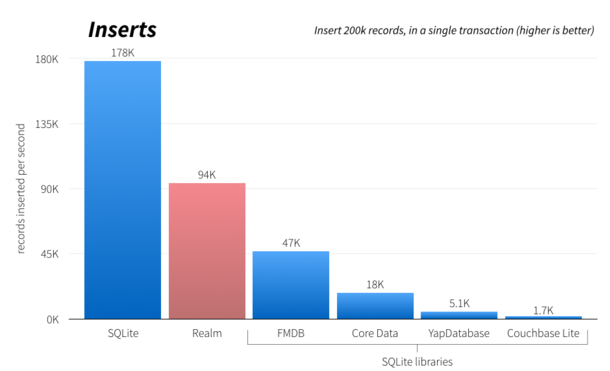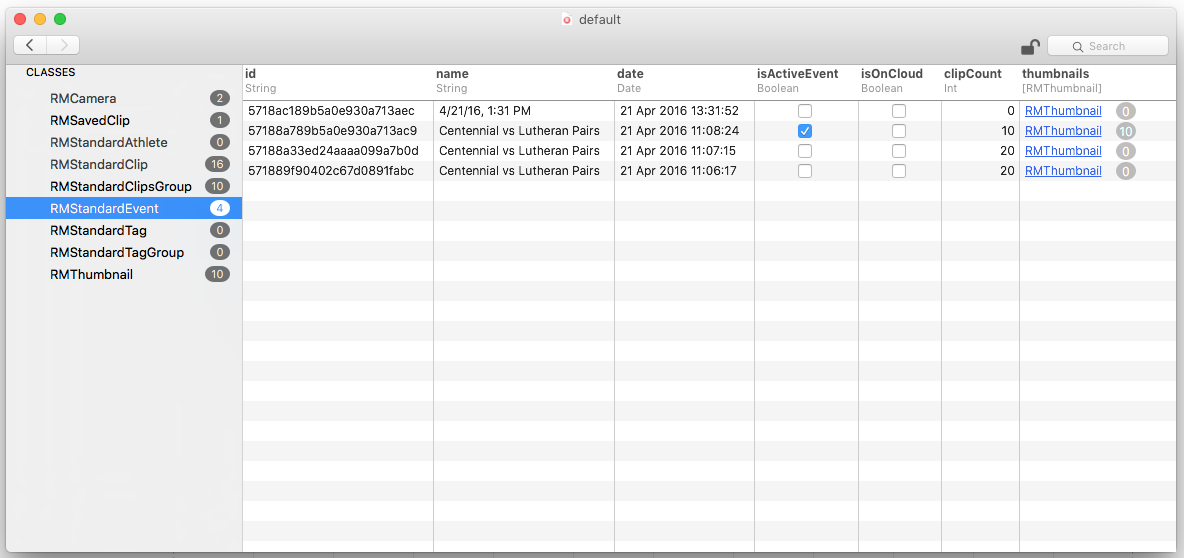Getting Dirty With Realm.io

@attheodo

What is Realm?
-
Realm is a truly mobile database.
-
Realm is a replacement for SQLite, Core Data, JSON/Property List files.
-
Realm is easy to use, fast, cross-platform and well supported.
1
Realm is a Mobile Database

-
Models!
-
Relationships (one-to-one, one-to-many)
-
-
CRUD!
-
Create
-
Read
-
Update
-
Delete
-
-
Queries!
-
Migrations!
-
ACID Transactions

Realm is a Replacement for

-
SQLite
-
FMDB is cool...
-
... said someone in 2011.
-
-
Core Data
-
Learning curve anyone?
-
ORM on top of SQLite
-
Complex API
-
-
Offline JSON/Plist files
-
Ok for small and simple transactions
-
Limited Flexibility
-
Too much I/O
-
Thread-safety? ACID?
-
Realm is easy to use

-
Realm is not an ORM on top of SQLite/CoreData/x
-
Custom C++ core with bit-packing, caching, vectorization and zero-copy architecture.
-
-
It has it's own conventions and data-structures that are easy to grasp and use.
-
Basically just 3 classes (Object, Arrays and Realms)
-
-
You can use Realm models convention to write all your app models if you want.
-
More later...
Realm is Fast


Realm is Fast


Realm is Fast


Realm is Cross-Platform

Objective-C, Swift
iOS, watchOS, tvOS
React-Native
Android

Realm Internals

-
Realm is truly innovative
-
MVCC
-
Native Links
-
Crash Safety
-
Zero Copy
-
True Lazy-Loading
-
-
Built from scratch with mobile platforms and limitations in mind
-
Why aim to be massively distributed?
-
Why aim to be shardable across instances?
-
Why be low latency over connection sockets?
-
Realm Internals

-
Realm is objects all the way down.
-
Most existing solutions are ORMs on top of something.
-
ORMs abstract what's going underneath
-
Objects become records/rows in tables with foreign keys and primary keys.
-
The abstraction kind of falls apart because you need to start traversing relationships using expensive operations.
-
Realm Internals

-
When you init a Realm, you're already "connected" to the database
-
Actually a fraction of the database is being memory mapped, there's no socket whatsoever.
-
-
As soon as you add an object (record) in Realm, it becomes an accessor.
-
Once you start reading properties from it, you are not accessing your iVars!
-
You access raw database values avoiding lots of memory copying.
-
Realm Internals (B+ Trees, Native Links)




Writer
Reader
HEADHEAD~1-
The file structure is just a tree of links.
-
Raw pointers to objects.
-
Same if you're querying for an Int, String or relationship!
Realm Internals (Crash Safety)




HEADHEAD~1-
As you make changes, you're forking the tree.
-
The top level pointer "HEAD" is always pointing to the latest non-corrupt tree.
-
When Realm verifies the newest write transaction (fsync()) it move's the top level pointer and get a new "official version"
Realm Internals (Zero Copy)

How most ORMs deal with data
-
Data sits on disk.
-
You access a CoreData model's property:
-
Translate request into a set of SQL statements.
-
Create database connection.
-
Perform the SQL query.
-
Read all the data from the rows that match the query and bring it to memory.
-
Deserialize from the disk format to something you can represent in memory (align bits).
-
Convert to the language type.
-
Realm Internals (Zero Copy)

How Realm does it
-
The data is still on disk but it's memory mapped.
-
You can access any offset in the file as if it was in memory, although it's not. It's in virtual memory.
-
-
Objects all the way down, everything is word-aligned (limitations)
-
The core file format is readable in memory without requiring deseriliazation (core Realm principle)
-
No copy to memory!
-
-
All you need is calculate the offset of the data to read in the mmap, read the value from offset up to offset + propery.length and return the raw value from the property access!
Realm Internals (True Lazy-Loading)

-
Hardware limitations don't allow to read just 1 bit form disk
-
Even if you want a Boolean property, you need to load the disk's page size, nothing smaller than that.
-
-
Most databases store things on a horizontal, linear level.
-
When you want a property from SQLite, you still have to load the entire row because it's stored contiguously in the file.
-
-
Realm stores properties contiguously linked at the vertical level in vectors (columns vs rows)
-
An object's property is never in an iVar unless you actually try to read it or modify it.
-
Installation
You guessed it. It's a Cocoapod.
pod 'RealmSwift'
Realm Models

-
Supported Property Types
-
Bool
-
Int8, Int16, Int32, Int64
-
Storing optional numbers is done using RealmOptional
-
-
Double, Float
-
String (can be optional)
-
NSDate (truncated to the second, can be optional)
-
NSData (can be optional)
-
Realm Models

import RealmSwift
class User: Object {
dynamic var firstname = ""
dynamic var lastname = ""
dynamic var nickname: String? = nil
dynamic var email = ""
dynamic var password = ""
dynamic var registrationDate = NSDate(timeIntervalSince1970: 1)
}Auto-incrementing id?
NOPE.
Realm Models

import RealmSwift
class User: Object {
dynamic var id = ""
dynamic var firstname = ""
dynamic var lastname = ""
dynamic var nickname: String? = nil
dynamic var email = ""
dynamic var password = ""
dynamic var registrationDate = NSDate(timeIntervalSince1970: 1)
override static func primaryKey() -> String? {
return "id"
}
}Or just map the id to your server database's id.
Realm Models

import RealmSwift
class Post: Object {
dynamic var id = NSUUID().UUIString
dynamic var postDescription = ""
dynamic var postPhotoURL = ""
dynamic var numOfLikes = 0
dynamic var createdAt = NSDate(timeIntervalSince1970: 1)
override static func primaryKey() -> String? {
return "id"
}
}Realm Models - Relationships

import RealmSwift
class User: Object {
dynamic var id = ""
dynamic var firstname = ""
dynamic var lastname = ""
dynamic var nickname: String? = nil
dynamic var email = ""
dynamic var password = ""
dynamic var registrationDate = NSDate(timeIntervalSince1970: 1)
let posts = List<Post>()
override static func primaryKey() -> String? {
return "id"
}
}One-To-Many Relationship
Realm Models

import RealmSwift
class Post: Object {
dynamic var id = ""
dynamic var postDescription = ""
dynamic var postPhotoURL = ""
dynamic var numOfLikes = 0
dynamic var createdAt = NSDate(timeIntervalSince1970: 1)
var postOwners: [User] {
return linkingObject(User.self, forProperty: "posts")
}
override static func primaryKey() -> String? {
return "id"
}
}Inverse Relationship
Realm Models - Ignored Properties

import RealmSwift
class User: Object {
dynamic var id = ""
dynamic var firstname = ""
dynamic var lastname = ""
dynamic var nickname: String? = nil
dynamic var email = ""
dynamic var password = ""
dynamic var registrationDate = NSDate(timeIntervalSince1970: 1)
let posts = List<Post>()
override static func primaryKey() -> String? {
return "id"
}
override static func ignoredProperties() -> [String] {
return ["nickname"]
}
}Realm Models - Indexes

import RealmSwift
class User: Object {
dynamic var id = ""
dynamic var firstname = ""
dynamic var lastname = ""
dynamic var nickname: String? = nil
dynamic var email = ""
dynamic var password = ""
dynamic var registrationDate = NSDate(timeIntervalSince1970: 1)
let posts = List<Post>()
override static func primaryKey() -> String? {
return "id"
}
override static func indexedProperties() -> [String] {
return ["id", "firstName"]
}
}Greatly speeds up queries at
the cost of slower insertions.
Creating Realm Objects

Way 1: Object Composition
import RealmSwift
var user = User()
user.id = NSUUID().UUIString
user.firstname = "Thanos"
user.lastname = "Theodoridis"
user.email = "at@atworks.gr"Creating Realm Objects

Way 2: Init from Dictionary
import RealmSwift
var user = User(value: [
"id": NSUUID().UUIString,
"firstname": "Thanos",
"lastname": "Theodoridis",
"email": "at@atworks.gr"
])Creating Realm Objects

Way 3: Init from Array
import RealmSwift
var user = User(value: [
"Thanos",
"Theodoridis",
"at@atworks.gr"
])Creating (Nested) Realm Objects

var post1 = Post(value: [
"postDescription": "Look, my dog! #dog #igers",
"postURL": "http://lala.com/dog.jpg",
])
var post2 = Post(value: [
"postDescription": "Look, my cat! #cute",
"postURL": "http://lala.com/cat.jpg",
])
var user = User(value: [
"id": NSUUID().UUIString,
"firstname": "Thanos",
"lastname": "Theodoridis",
"email": "at@atworks.gr",
"posts": [post1, post2]
])Persisting Realm Objects

let realm = try! Realm()
var user = User(value: [
"firstname": "Thanos",
"lastname": "Theodoridis",
"email": "at@atworks.gr",
"posts": [post1, post2]
])
try! realm.write {
realm.add(user)
}Updating Realm Objects

let realm = try! Realm()
user.lastname = "Papadopoulos"
try! realm.write {
realm.add(user, update: true)
}-
This will work only if the User object has a primary key.
-
If not, you need to enclose `user.lastname` in a `write()` block.
-
-
If you omit `update: true` and an object with that key already exists, you get an exception (if unhandled, you crash)
Queries

-
All queries return a `Results` instance with a collection of Objects.
-
All queries are lazy.
-
Data is only read when the properties are accessed.
-
-
Results are not copies.
-
Modifying a Results object within a write transaction will persist to disk.
-
-
Query execution is deferred until the results are used.
-
Once a query has been executed, the Results object is up to date with any other changes in Realm.
Queries

-
The equivalent of `SELECT * FROM 'USERS'`
let realm = try! Realm()
let users = realm.objects(User)Complex Queries?
NSPredicate()Queries for Relationships

let realm = try! Realm()
// Forward relationship
let user = realm.objects(User).first
let posts = user.posts
// Inverse (backward) relationship
let post = realm.objects(Post).first
let postUser = post.postOwners.firstQueries using NSPredicate()

let realm = try! Realm()
// Get a user with a matching id
let predicate = NSPredicate(format: "id == %@", id)
let user1 = realm.objects(User).filter(predicate)
// Get users with GMail accounts
predicate = NSPredicate(format: "email ENDSWITH %@", "gmail.com")
let users = realm.objects(User).filter(predicate)
// Get top active users
predicate = NSPredicate(format: "posts.@count > 100")
let activeUsers = realm.objects(User).filter(predicate)
// Get users registered before Christmas
predicate = NSPredicate(format: "date <= %@", christmasDate)The Realm Database

-
Realm() gets you the default Realm database.
-
A file named `default.realm` in /Documents
-
var config = Realm.Configuration()
config.path = NSURL.fileURLWithPath(config.path!)
.URLByDeletingLastPathComponent?
.URLByAppendingPathComponent("NewName.realm")
.path
// set tihs as the config for the default realm
Realm.Configuration.defaultConfiguration = configThe Realm Database

-
But you can use as many different Realms as you want!
let config = Realm.Configuration(
path: myPathToBackupRealm.path
readOnly: false
)
// Default Realm (default.realm)
let realm = try! Realm()
// Backup Realm (backup.realm)
let otherRealm = try! Realm(configuration: config)The Realm Database

-
You can also have in-memory Realms
-
Cool for caching layers
-
let memoryCache = try! Realm(configuration:
Realm.Configuration(inMemoryIdentifier: "com.me.cache")
)-
Beware of in-memory instances going out of scope with no references.
-
Garbage collector will wipe your data off
-
-
Keep a strong reference to your in-memory Realms.
The Realm Database

-
You can also bundle prepopulated Realms with your app.
-
In the code where you generate the prepopulated Realm, make sure to "compact" it:
Realm().writeCopyToPath(_:encryptionKey:)-
Drag and drop and add it in "Copy Bundle Resources" of your build phase.
-
If you need to mutate this Realm, your first need to copy it to your application's Documents directory. Bundles are read-only.
Thread Safety

-
One golden rule:
let realm = try! Realm()for each thread
-
Realm state for each thread will be based off the most recent confirmed transaction commit and will remain there until that version is refreshed.
-
States are automatically refreshed at the start of every NSRunLoop iteration.
-
Background threads that do not have run loops must explicitly call Realm.refresh()
-
Notifications

-
Two options for monitoring updates on Realm objects:
-
Collection Notifications
-
KVO
-
let userModelNotificationToken: NotificationToken!
userModelNotificationToken = realm.objects(User).addNotificationBlock {
notification, realm in
usersTabelView.reloadData()
}
// When no longer needed
userModelNotificationToken.stop()Migrations In Realm

-
Data models change...
-
Realm models are parsed and validated during compile-time.
-
But, if Realm sees a mismatch in models and the database during run-time, it throws an exception and doesn't let you read or write to the db.
-
... Unless you run a migration!
Migrations In Realm

// v1 Model
class User: Object {
dynamic var id = ""
dynamic var firstname = ""
dynamic var lastname = ""
dynamic var nickname: String? = nil
dynamic var email = ""
dynamic var password = ""
dynamic var registrationDate = NSDate(timeIntervalSince1970: 1)
}
// v2 Model
class User: Object {
dynamic var id = ""
dynamic var fullname = ""
dynamic var nickname: String? = nil
dynamic var email = ""
dynamic var password = ""
dynamic var registrationDate = NSDate(timeIntervalSince1970: 1)
}Migrations In Realm

// application(application:didFinishLaunchingWithOptions:)
Realm.Configuration.defaultConfiguration = Realm.Configuration(
// Increment the db schema version
schemaVersion: 1,
// Perform the migration
migrationBlock: { migration, oldSchemaVersion in
if (oldSchemaVersion < 1) {
migration.enumerate(User.className()) { oldObject, newObject in
let firstname = oldObject!["firstname"] as! String
let lastname = oldObject!["lastname"] as! String
newObject!["fullname"] = "\(fistname) \(lastname)"
}
}
}
)Encrypted Realms

-
Realm supports encrypting the db file on disk with AES-256+SHA2 and 64byte keys
let key = NSMutableData(length: 64)!
// Generate random key
SecRandomCopyBytes(
kSecRandomDefault,
key.length,
UnsafeMutablePointer<UInt8>(key.mutableBytes)
)
// Save it securely in keychain
// Always pass it in default Realm configuration
// to be able to use encrypted Realm file
Realm.Configuration.defaultConfiguration.encryptionKey = keyRealm Browser


print(Realm.Configuration.defaultConfiguration.path!)
// or
(lldb) po Realm.defaultPath Questions?
@attheodo
http://attheo.do

Getting Dirty With Realm.io
By Thanos Theodoridis
Getting Dirty With Realm.io
- 569



